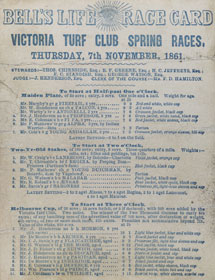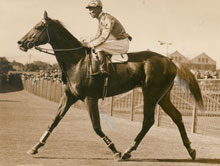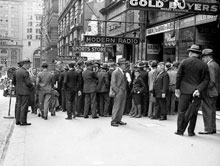Melbourne Cup: 'The race that stops a nation'
The Melbourne Cup is Australia's major annual thoroughbred horse race. Billed as 'the race that stops a nation', it is a race for horses aged three-years-old and over, and covers a distance of 3200 metres.
The event has been held by the Victoria Racing Club (VRC) at Melbourne's Flemington Racecourse in the first week of November since 1861. It is generally regarded as the most prestigious 'two-mile' handicap race in the world. Originally, the trophy was a gold watch, with a purse of 710 pounds. The current trophy (awarded since 1919) is a three handled gold loving cup worth $75,000 at 2005 prices.
Melbourne Cup race card, 1861, by Bell's Life
Printed card A2127
On 7 November 1861, a crowd of 4000 gathered at Flemington to witness the first Melbourne Cup. The Victorian Turf Club announced that the Melbourne Cup was to be a fair contest in which the best horses would be handicapped, ie. weighted down, to make the race more equal. Older horses were given more weight than younger ones and weightings were adjusted according to the horse's previous results.
The hot favourite of the inaugural Melbourne Cup was a local horse, Mormon, with bookies dismissing the chances of a NSW runner called Archer. A fall during the race brought down three horses, killing two and breaking a jockey's arm, but the field kept going. To the delight of the local crowd, Mormon made his dash for the line at the home turn but Archer ran him down to finish first past the post. Archer went on to win the Melbourne Cup twice, taking a lot of money away from Melbourne, refuelling interstate rivalry and adding further excitement to the Melbourne Cup.
By the end of the 19th century the Melbourne Cup had become a national event. In 1877, the first Tuesday in November was officially declared a public holiday in Melbourne which ensured crowds flocked to the track. From 11am on Cup Day spectators packed the Flemington grandstand to its 7000 capacity, and the masses thronged the hill beyond. By 3pm, the starting time of the race, up to 150,000 people may have assembled - making the annual Melbourne Carnival a public spectacle unequalled in the southern hemisphere.
For over a century, only two horses had won the Melbourne Cup twice: Archer (1861, 1862) and Peter Pan (1932, 1934). Bred in NSW in 1929, Peter Pan went out as the 4 -1 favourite in the 1932 Melbourne Cup before striking interference and appearing to go down. With a grass stain on his nose, he miraculously managed to regain his feet and come from the back of the field to win the race by a neck.
Above left: Peter Pan and jockey Jim Pike, c.1934, by unknown photographer, Photograph PXE 653/16/9
Above right: Crowds listening to Melbourne Cup, Sydney, c. 1934, by Ted Hood, Photograph H&A 1081
Peter Pan's 1934 Cup win was no less incredible. Hailed as one of the finest staying performances in Australian turf history, this champion of champions was carrying a top weight when he raced in mud up to his hocks to win by three lengths in one of the slowest times on record.
Many Melbourne Cup winners have become part of Australian folklore. While the Cup will continue to evolve, it remains the greatest 3200 metre handicap horse race anywhere in the world and, by the nature of the conditions, arguably one of the most challenging to win.





